6 best work schedule apps for seamless shift scheduling

Work schedule apps can reduce the burden of shift planning for managers and enable teams to cooperate in one digital workspace to plan their work schedules.
Since now more and more companies work remotely or in a hybrid form, juggling time zones and tracking no-shows has become trickier than ever. The use of such software is, therefore, becoming more widespread.
Want to get the most out of your time?
Try DeskTime for free!
Try free for 14 days · No credit card required.
By signing up, you agree to our terms and privacy policy.

In this post, we’ve selected six tools that you can use to manage your team’s schedule:
But first, let’s take a look at what are work schedule apps, some of the key benefits of using them when managing a team.
What is a work schedule app and how does it work?
In a nutshell, a work schedule app is a web or mobile application that you and your team can use to plan, schedule, and manage shifts.
Instead of having to do troublesome—and manual—messaging or calling to your team members to put together a schedule, you can do it in a few clicks via your employee work scheduling app. Employees are notified about the updates and can approve/decline these suggested shifts. And in case somebody wants to swap their shifts or doesn’t turn up, you can use the app to regroup your human resources. Work schedule apps for managers can be a massive timesaver.
Top 5 benefits of using an employee schedule app
Work schedule apps make shift scheduling smoother and more seamless for both employees and managers. With everything available in one place—typically in the palm of your hand—it can be a massive boon to productivity and quality of life.
Using a work schedule app:
- Makes shift scheduling fast and error-proof
- Provides for increased shift planning transparency for everyone
- Helps you plan and adjust individual working plans
- Allows you to schedule the appropriate number of stuff for each shift
- Enables businesses that work on a per-hour rate to track hours and manage resources
Different schedule making apps are suitable for different scenarios. In this article, we have collected the apps that suit both in-office and remote teams.
Comparison of best team scheduling apps for employees
Here is a brief comparison of best scheduling apps for employees and managing shifts.
| App | Reporting | In-built chat | Bottom-up scheduling | Ready-made templates | Additional team management features |
|---|---|---|---|---|---|
| DeskTime | + | + | + | – | + |
| When I Work | + | + | + | – | + |
| Shiftboard | + | – | + | + | – |
| Connecteam | + | + | + | – | + |
| Humanity | + | + | + | + | – |
| Homebase | + | + | + | – | + |
Top 6 apps for scheduling employees’ shifts
Let’s have a closer look at applications that can make scheduling shifts much easier.
1. DeskTime
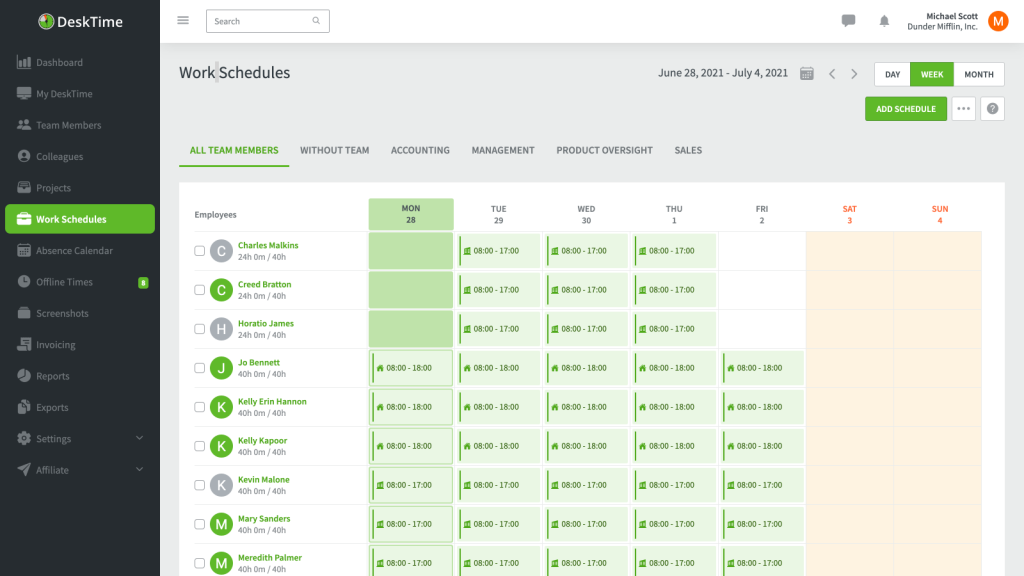
DeskTime is a full-fledged productivity app that helps companies with shift scheduling. You can create personalized schedules for different teams or individual employees. When creating schedules, managers can indicate things like total working hours, as well as the minimum hours to work. The dashboard is accessible and transparent to all employees.
DeskTime’s bonus is that it also offers time tracking, productivity analysis, and the possibility to create efficiency and productivity reports.
DeskTime can be used by both large and small teams. As follows from the name, the app was originally designed for teams that work on computer-related tasks, however, it has evolved and is now being used across a multitude of industries and work environments.
Key features: Easy shift assignment, Shift requesting, Shift templates, Time tracking
Pros:
- Easy to use & set up
- Free trial
- Plethora of additional time management features, if needed
- Perfect for different types of in-person, hybrid, and remote teams
- Great customer support
Cons:
- Shift scheduling is part of the premium plan, which is intended for growing and large teams
2. When I Work
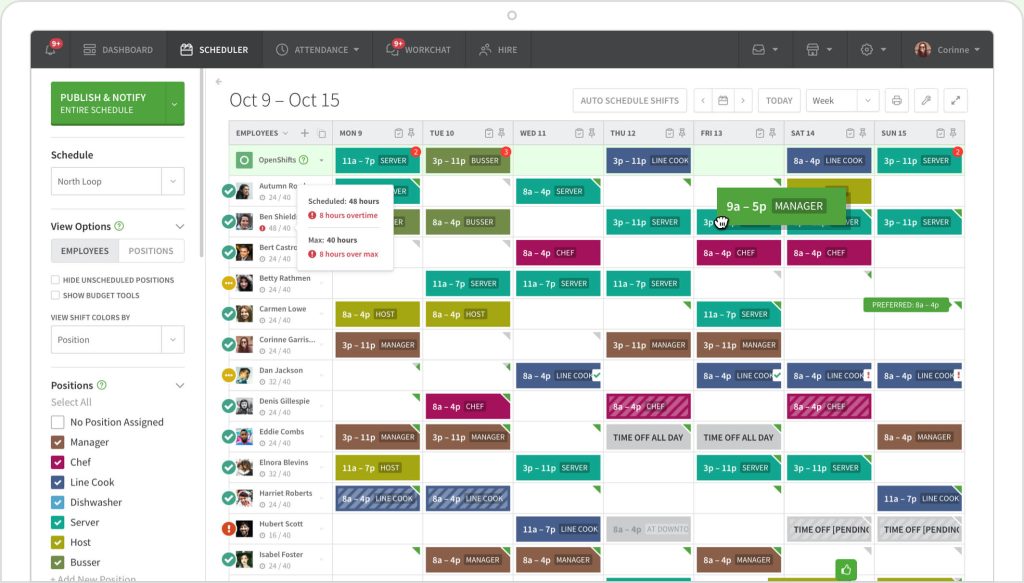
When I Work is an employee schedule app that allows you to create and update timetables in minutes. If employees need to shuffle shifts they can do it with a few clicks through their user-friendly graphical interface. The manager just needs to approve the changes.
You can select employees from the list and assign shifts in two clicks. Plus, you can use color coding for different roles to improve clarity when planning shifts. When I work also includes time tracking and analytics tools for labor forecasting that help you with labor budget planning based on historical data.
The app can be used both by office and deskless teams but will be most beneficial for businesses that work in manufacturing, hospitality, etc. It provides the team with an online chat feature where team members can communicate with each other, and the app also runs on a smartphone.
Key features: Auto scheduling, Labor forecasting, Schedule enforcement
Pros:
- Mobile app
- Free trial & low pricing
- Color coding & drag-and-drop functionality for ease of use
Cons:
- Not ideal for organizations with multi-tiered management
- Runs into issues when multiple people use it at the same time
3. Shiftboard
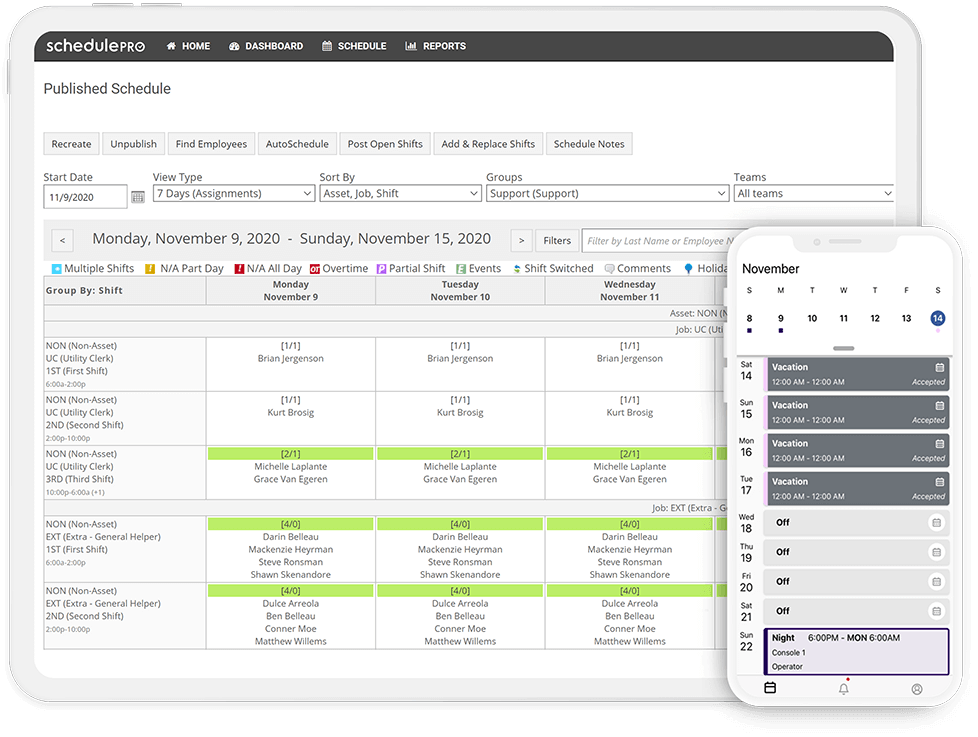
Shiftboard is one of the best apps for scheduling employees for mission-critical industries. It helps to productively organize processes for companies in both product-oriented (manufacturing, petrochemicals) and service-oriented (such as healthcare, hospitality) industries.
To meet the various needs of its users, Shiftboard provides not one but two solutions:
- Service-oriented businesses can use Schedule Flexsoftware to self-schedule shifts, track meetings and events.
- For product-oriented companies, they offer SchedulePro software with site-specific shift planning options, overtime detection and optimization.
Using an app like this in the above-mentioned industries is essential since employee disengagement and bad management can cause direct financial loss or even put human lives at risk.
Key features: Supports industry specific scenarios, Diverse worker input options, Continuous coverage optimization
Pros:
- Mobile accessibility
- Easy-to-understand user interface
- Templates for various industries and scenarios
Cons:
- Limited customization
- No free trial
4. Connecteam
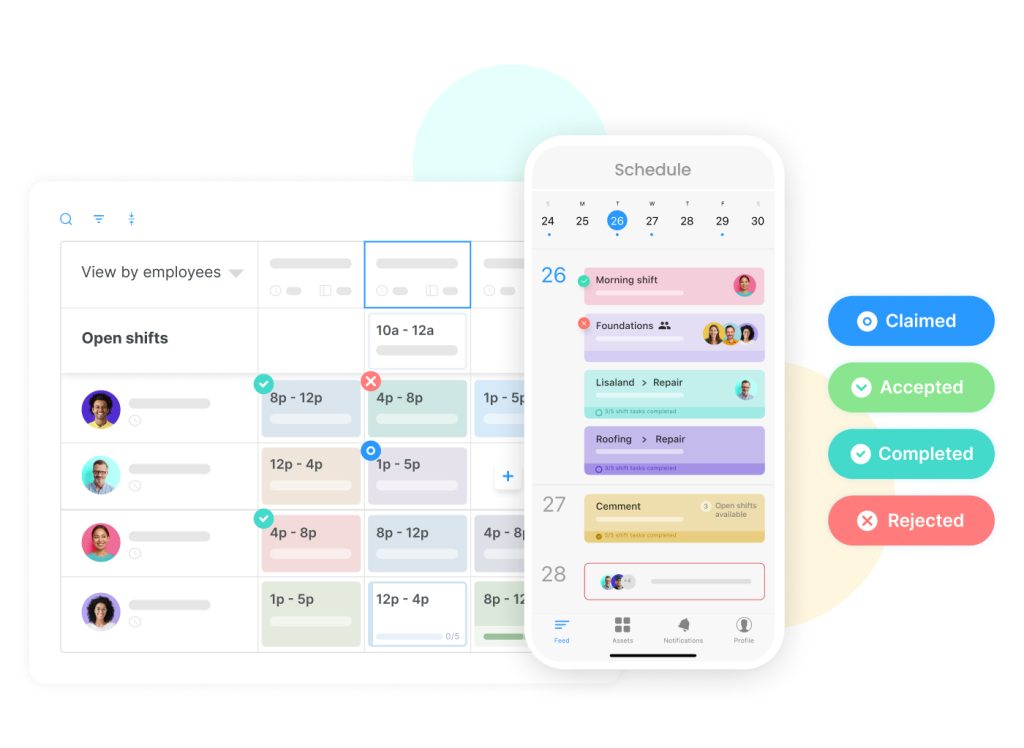
Connecteam is a communication hub for deskless teams. If you work in retail, hospitality, security, or construction, you might want to have a closer look at this employee work schedule planner. It enables you to plan shifts, assign tasks, and track hours in a single easy-to-use app.
This application enables businesses with deskless or mixed workforces to ensure efficient workplace communication. A significant benefit of Connecteam is that it provides your team with an in-app chat feature and a shared knowledge base to onboard and train employees. It also has a feature for creating employee surveys.
Key features: Team scheduling, Geofencing, One-click Payroll
Pros:
- Free trial & free plan for teams up to 10 people
- Extensive range of features for employee communication & engagement
- Great customer support
Cons:
- Limited integrations
- Steep learning curve
5. Humanity

Humanity is a job schedule app that runs on desktop, mobile, or tablet. With the help of Humanity, you can reduce the time you spend on creating schedules by 80%. At the same time, you keep your timetable error-free by using case-specific templates and setting up availability rules.
This app for shift work scheduling focuses on providing employees with the best customer experience via an interface that is intuitive to use even to not so tech-savvy teams. Employees can request to drop or shuffle the shifts, managers just need to approve the changes. By making the scheduling process more efficient, Humanity allows business owners to reduce overhead costs tied to scheduling shifts.
Key features: Shift planning, Demand scheduling, AI-powered forecasting
Pros:
- Easy to use & user friendly
- Lots of features
- Mobile app
Cons:
- Cannot start an instant trial
- Suboptimal customer support
- Expensive
6. Homebase
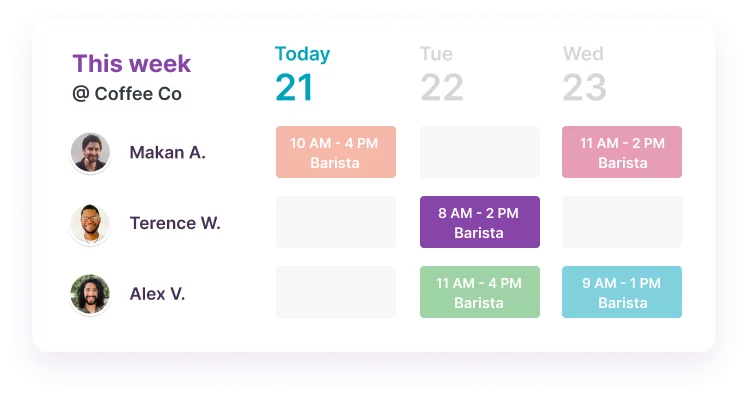
Homebase is a handy platform for businesses that work by an hourly rate model. Using this app, you can not only manage shifts but also onboard new employees, communicate with the team, and control labor costs. Homebase provides specialized tools for each of these purposes.
The app simplifies the process of scheduling shifts by allowing managers to create a unified timetable and share it with everyone in their team. Moreover, Homebase has an in-built time tracking system so that you could easily keep track of the amount of hours your employees have worked—be it in the office, at home, or even on-site, with the help of a GPS clock tracker. Then, you can convert hours into wages and pay in a few clicks.
Key features: Shift scheduling, Time tracking, Easy payroll
Pros:
- User-friendly interface
- Free trial & basic free plan
- Responsive customer support
Cons:
- Missing some features, such as employees picking up hours outside their scheduled hours

Be smart about your time!
Use DeskTime for shift scheduling and always stay on top of your team’s hours.
How to choose the right work schedule app for your needs?
As you can see above, not all apps are created equal and some will suit specific industries, scenarios, and teams better than others. To find the best shift work schedule app for your particular needs, we suggest the following:
- Understand what exactly you will use the app for
- Determine if you require any additional features beyond shift scheduling
- Explore the pricing plans and do some napkin math to understand how much it will cost
- Read the reviews and pay special attention to one’s from other people in your industry
- Simply try them out—the user experience is key
At the end of the day, it’s a tool that you will use on the daily. The most feature-rich super app might sound great on paper, but if using it is a major hassle for everyone involved, then the effect can be counterproductive. Try out several options that speak to you and pick the one that you find the easiest to use! Don’t hesitate to ask your employees for their input, too.
Use work scheduling software and be more organized
Shift planning software will help you reduce the time you spend on managing shifts, so that you and your employees can concentrate on what you do best. Moreover, these tools can help you improve communication within your team members and make them feel more connected, especially if you work remotely.
Did you find this article useful? Give it a clap!
Psst! You can clap more than once if you really loved it 🙂